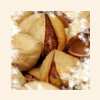Search the Community
Showing results for tags 'Bread'.
-
I've been baking a couple loaves of whole wheat today, and after I put them in the oven it occurred to me that baking and brewing (I do both) have a lot in common. Both use different types of grains for different flavors, both rely an enzymes to convert complex carbohydrate to simpler sugars, and both include fermentation. So I got to thinking, what other ways do they intersect? What ideas can I take from one process and apply it to another? The first thought I had was using heat to convert complex sugars into simpler ones in baking. This is required in brewing, as the sugars contained in barley aren't wholly digestible by yeast. So I've been contemplating experimenting with holding pastes at different temperatures to try and control the enzymatic process. It probably won't work, but might be worth a little exploration. While thinking about that, I realized that perhaps a better experiment would be to use specialty grains directly in whole wheat bread. Specialty grains in brewing, for those who are unfamiliar, are grains that are used to control the color and flavor of the brew. For example, barley is roasted at high temperatures to create black malt, chocolate malt, black patent, and many others which contribute highly to the flavor of stouts. Same with amber malts, crystal malt, peat malt (used in Scotch whiskey), and many others. So my question is this: has anyone tried, say, an oatmeal stout wholegrain bread? Not actually using beer in the bread, but the grain profile used to make a stout. I have a nice grain mill, so I should be able to process any grain. Any experience, thoughts, or gotchas? Cheers, and happy saturday!
-
I'll confess. I'm new to bread baking, but finally have some starter, that "barmed" is rising like crazy, and starting to make my bread more sour. But, my bread is denser than I'd like, and I have a bunch of questions (all related to non-loaf pan loaves): Shaping. If I flour the counter, I can't seem to get as much tension. Quite frankly, my shaping sucks, and I can't seem to get the tension that is necessary for a Great Loaf. Slashing. When do I do this? If I slash right before I put the loaf in the oven, I don't seem to get the bloom I need. Couching. What's the best way to keep a wet dough from spreading too much? Today, the loaves are couching on a floured flour sack dish cloth, kept in check with bricks. Or, do I even care if the loaves spread? It's helpful it the bread is taller so the kids can get their toast out of the toaster... What's the best way to transfer these loaves so they don't wrinkle? Plea for help, please! How do I know when they are over-proofed?
-
I would be very grateful if anyone can help, I shoot a few deer a year, where can I find (or can you post) pictures of the glands, so I can try these beautiful morsels again. I have been out to a local restaurant and tried open ravioli with chicken and sweetbreads with portabello mushrooms with a truffle velute sauce....... superb.
-
Here on this other topic, sourdough breads are discussed in wonderful detail, with tons and tons of great info. I've posted a number of pix of 100% sourdough breads, along with tales of failures, and some successes along the way. My "mother" is quite healthy, and just takes one feeding to get it all hot and bothered. And now I have a confession about my latest bread... , the one pictured above. I actually used a tiny amount of SAF instant yeast - like 1/4 tsp. added when I first mixed the starter, flour and water, and prior to autolyse. Dough had about a two hour rise (folded after an hour) after kneading, followed by the long overnight proof in the refrigerator. And then baked in an enameled cast iron Dutch oven. And it's one of the best loafs I've managed to produce...nice rise, decent, if not great, holes, light in the hand, great crust, creamy delicious crumb, delicious toasted or not. I've made some pizza dough using the same tactic (sourdough + a tiny bit of yeast) and my wife thought it was the best one I've yet made. Many commercial bakeries (at least according to the labels on the breads) seem to use a bit of yeast in their sourdough formulas. And it just seems to make my breads so much better and more successful to bake. So, is this heresy amongst sourdough aficianados? Are there any breads you bake with both sour and yeast? And, what the hell is going on with all those bacteria and yeasts and things when you use both?
-
Since I've been focusing on sourdough breads, rustic breads, no-knead breads, pizza, focaccia, etc. for oh, these past 12 months or so, I decided to give a simple whole-wheat loaf a try. I modified slightly the whole wheat bread recipe in the King Arthur Flour All-Purpose Baking Book, substituting 1/3 a/p flour for the whole wheat called for in the recipe. Also, instead of honey, molasses or maple syrup, I used agave nectar, since I had just bought a bottle of the stuff. Kneaded in my KA stand mixer (I really wanted to make this easy - I usually knead by hand), risen once for 2 hours, shaped and risen again in the loaf pan for 1 hour, here's what I ended up with. A tasty, wheaty, damn easy, even a little bit healthy loaf of bread that I can easily slice up for toast in the morning or to make a sandwich with at lunch. No biga. No poolish. No starter. No spritzing or pouring boiling water into my oven. No overnight stuff. No almost burning the shit out of my hands and arms dumping a bread into a 450 degree cast iron dutch oven. Will not and can't replace all the above, but it makes me happy. Show us your loafs.
-
Hey all, Working on improving my bread skills. I'm now thinking of upgrading my equipment list to hopefully make things a bit better. I realize that you can make pretty great bread at home with minimal tools, but I was wondering what everyone's opinions were of the required equipment. Obviously we can assume an oven, etc. But aside from that, what are the top needs? For example, do I really need a special loaf pan for baguettes? Thanks.
-
I have a friend who was recently informed me that he had to cut back on his sodium intake. And his biggest regret? Having to cut back on the breads. And since I do have a love for the breads, I told him that I would help him tweak his aunt's bread recipe. I know that salt plays two important roles in breadmaking: 1) Flavor ... no salt bread just tastes flat 2) Controls fermentation So, my basic question is this ... if I reduce the salt by, say, 50% in my recipe, would I reduce the amount of yeast needed by that amount, too? Anyone have any experience in doing reduced-sodium breads? Also, is there something I can use in place of salt that could also help to reduce the amount of sodium, but still keep the flavor?
-
I am having a throng of people for thanksgiving. I am making my own bread but there are some people coming with very plain tastes and I want to put out an assortment of rolls, bread on the table. I cannot find a place to get very good bread out in Chesco. We have a few road trips to the airport to make on Wed before. So up Route 1 and 95 would be great. Is there no bread this way? Help Help!!!
-
After ordering and receiving a brotform, I've decided to buy some cane and make my own. I also am going to make some linen lined baskets as bread rising baskets. Now I found an idea for a homemade cloche made from a terracotta flower pot, tray, eyebolt, nuts, and some washers. If my bread made in it doesn't suit me I can plant some herbs. http://home.att.net/~carlsfriends/carlospi...tisanalLoaf.htm I've built dozens of kilns for ceramics - now to convince myself to build a woodfired oven on my patio.
-
I would like to know if there is an "official" definition of Artisan?
-
I have baked bread occasionally, but never really managed to hone my skills due to lack of proper facilities, etc. Now, I am engaged in a long-term house-sitting gig, with a fabulous kitchen, and I'm currently working on my first batch of sourdough bread. My favourite bread, however, is Pao de Mihlo (Portuguese cornbread), which I can only get when I'm in Toronto. Does anybody know how to make this stuff?
-
I recently came back from Hamberg where I ate some of the most amazing breads I've ever tasted. I want to find a book that will describe and tell me how to make these breads. I I'm not real interested in pastry but breads and rolls that are savory. Any and all ideas will be pursued, Thanks. Robert
-
A customer just finished reading this book and its atop my must read list. Interesting since its 60 years old! From what the customer relayed to me, I'm anxious to give a modern read to this aged writing. From amazon: Whomever is going to get it for me for the holidays, paperback will be fine [note: The amazon description shows it from 1997, but my customer said it was written in the 40s]
-
I recently was made aware of something called Fairy Bread. Basically its bread with butter and sprinkled with Jimmies or Sprinkles. Usually its the hard round sprinkles. But I adore it with the soft long jimmies. Its kids Birthday Party fare in Oz. Why isnt Fairy Bread in the USA? Its unfathomable why the Soccer Moms in the USA havent taken Fairy Bread and expanded upon it and opened Fairy Bread shops, with special breads and Jimmies etc... Its absolutely gorgeous on a plate, piled high... Look: http://en.wikipedia.org/wiki/Image:Fairy_Bread.jpg Come on people lets bring Fairy Bread to the states!
-
With the sudden closing of ecco il pane, I'm at a loss as to where to purchase good par baked bread. Does anyone have a favourite they use / buy? Any brands you dislike? thanks...
-
Greetings board, Are there any places where I can buy Cuban bread either in Morris or northern Essex counties? I live in Roseland and would love to occassionally pick up some Cuban bread for sandwiches but don't feel like making the trek into Union City. Suggestions?
-
We have a brand new oven. A GE profile, dual fuel with convection. I baked some cookies with the convection feature and they came out great. I was hesitant to bake a loaf of bread using the convection feature though. I'm not sure why, I thought it might deflate it or dry it out. What do you think? Yes or No?
-
Here's a question for all you food chemistry eggheads: If the goal is sturdiness and long shelf life (unaided by non-edible support structures), not taste, then what aspect of a gingerbread house dough recipe is most important? Submitted for your approval are a collection of multifarious recipes, all of which are reputed to be the perfect concoction for making gingerbread houses: 1.) Teresa Layman's Recipe (Author of Gingerbread for All Seasons) http://www.vegsource.com/talk/veganism/messages/953365.html 2.) Deni's Deluxe Dough (Top 10 finalist at the Grove Park Inn National Gingerbread House Competition) http://home.comcast.net/~frankysattic/denidough.htm 3.) Christina Banner's Recipe (Grand Prize winner of the GPI competition and Food Network Challenge winner) http://www.foodnetwork.com/food/recipes/re...6_32442,00.html 4.) Elizabeth Prioli's Recipe (Grand Prize winner of the GPI competition) http://www.cottageliving.com/cottage/food/...1127969,00.html 5.) Good Housekeeping Recipe ("Nettie's Gingersnap Dough" printed year after year in the annual Christmas issue) http://www.goodhousekeeping.com/recipefind...read-dough-1571 6.) Pastry Chef Central ("The finished baked items will not absorb moisture nor become dry and brittle!") http://www.pastrychef.com/Gingerbread-House_ep_105.html But what is it that really makes one recipe superior to another? Are the specific ingredients used the most important element for success, or is it the ratios of those ingredients to each other? Or, is the mixing method the key to success? One recipe claims honey outlasts molasses, some recipes use margarine not shortening, some use eggs and some don't. Some recipes use roughly equivalent amounts, by weight, of fat and sugar, others use more sugar than fat. One recipe uses very little viscous sweetener, while others use a lot. Some recipes cream the fats and sugars like regular cookie dough, others melt the fats with the syrup/sugar and still another recipe skips this step altogether and uses oil. Based on your knowledge of baking chemistry, what is paramount to gingerbread house success? Is it the specific ingredients used, the ratios utilized, or the mixing method? Or am I barking up the wrong tree altogether? Does it all come down to environmental conditions (humidity) or technique (architecturally sound house design, coating the gingerbread with royal icing, or using an edible fixative, etc.)? Looking forward to this discussion! E.
-
I'm a pastry chef more into plated desserts, but my new job requires baking lots of different breads and developing recipes for multiple locations. I have a couple of recipes that use a biga starter that are successful, but I'm concerned about consistency using the biga day 1 vs. day 3. I've been trying to get a sourdough starter going, but this morning I decided it wasn't happening and threw it away. My question is, can I just use the biga as a jumping-off point for sourdough and feed it? Can/should I add old biga to the fresh batch to enhance the flavor, or should I stick with making a fresh biga every 3 days? Making it fresh seems to work fine, I'm just looking for ways to make better bread. I do add yeast to the breads also, and although I would like to do a slow rise, space and educating my staff are issues, so I'm depending on the pre-fermented starter to add complexity. If I do get a sourdough starter going, is there any point in keeping both sourdough and biga starters, or is one enough? I'm inclined to just use one, unless there's a compelling reason to keep two cambros of fermenting goo in my reach-in. Thanks! Andrea
-
I'm fully dipping shortbread in tempered chocolate, but for every batch that I make, a few finished ones develop blotches of a fatty film on the bottom. It seems like fat from the butter is leaking out from the cookie. It usually happens at a weak point in the chocolate coating, but there's sometimes no discernible point of exit. Any ideas how this could be prevented? The shortbread is made with very soft butter, salt, sugar, and flour, and baked until golden brown. It's a crunchy shortbread. I've tried pre-coating the cookie in untempered chocolate b/c I thought that maybe the tempered chocolate was contracting too strongly directly on the cookie... but it didn't make a difference. Neither did baking them the night before, and putting them on paper towels to soak up some fat. Maybe some sort of starch would help? I want to keep it as crunchy as possible, though...
-
Is there such a thing as a dense, hearty, whole grain bread made without the need for all the kneading, rising time associated with many breads? Something like a whole wheat into which one can add nuts or other ingredients, maybe let it sit a bit, and then bake? I sort of remember some breads like that from the "old" days - maybe some recipes from Moosewood or Mollie Katzen? I'd like to make something to go with a good veggie soup or broth on cold winter days. Any recipes, suggestions, or pointers would be welcome and appreciated. shel
-
Soaked in Milk, par boiled a huge amount.. Have close to 3 pounds left over.. I was wondering if I can freeze the rest or do I have to eat all this in the next day or so..
-
I thought that there may have been a thread concerning this book but I couldn't find one. Do any of you have it and if so how well do the recipes work? It reads as if it is well researched but I haven't had a chance to make any of the wonderful sounding breads.
-
I'm looking to make some muffins (as in the sweet, muffin case cake-like) kind, but with the addition of yeast. Would this work? What kind of texture would it yield? I'm hoping it would make them taller/lighter. If not, has anyone tried whipping the egg whites seperately?
-
Over on the Restaurant Life forum the topic "Some thoughts on restaurant bread rituals" briefly touched on the question of why freshly baked bread gives you a belly ache if you eat it when it is still hot. Does anybody here in the Baking forum have an answer?














